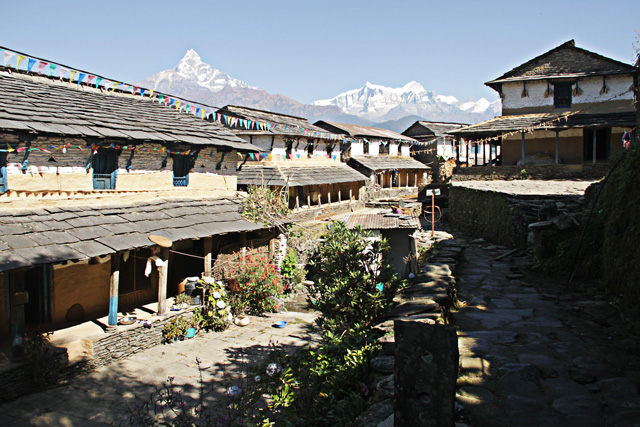
It was already November. And I couldn’t bear the thought that I was going to end this year without traveling to any new place. So last weekend, without any planning, I went on a two-day trek to Dhampus.
I think there aren’t many places so close to Pokhara that offers you an escape like the Dhampus trek. The hike’s moderate length and low elevation makes it suitable for anyone, and the best part of the trek is that it is doable on weekends without affecting your other aspects of life.
Hike from Phedi to Dhampus

I took a morning flight to Pokhara on a Saturday. After landing, I met the guide and we headed to Phedi in a cab. We reached the trailhead in half-an-hour, and started the trek from there at 11:00 a.m. The climb was very steep for the first 10 minutes, then it got moderately easy as we ascended gently out of the woods. The road continued along a narrow footpath that led us up a little village of lalupatey flowers and millet fields. Many times when the trail increased in grade, we rested under the tree shades, and sometimes, we stopped by a local shop for mohi and guavas.
After light refreshments, when we were climbing uphill again, we saw many picnickers coming down from Dhampus. As it happened, it was picnic season here, and there was a trend among people to go on a picnic from the deuse bhailo in Tihar. We reached Dhampus in three hours, but it can be easily done in two hours if you don’t need to rest much.
The vantage point near the bus station offered majestic views of the Machapuchhre and Annapurna range, and we could also see the motorway from where we had started our climb. We passed some more picnic-goers sprawled around on every open space in restaurants as we followed a narrow cobbled street winding up the hill between beautiful stone houses, millet fields, lodges, and restaurants on our way to Tsukinoie, a small lodge, where I stayed the night.
Tsukinoie
 Tsukinoie is a beautiful lodge in Dhampus where you can wake up to stunning panoramic views of Annapurna South, Hiunchuli, and the Machhapucchre peaks right through your window, or while lounging on the open terrace of the lodge.
Tsukinoie is a beautiful lodge in Dhampus where you can wake up to stunning panoramic views of Annapurna South, Hiunchuli, and the Machhapucchre peaks right through your window, or while lounging on the open terrace of the lodge.
On my arrival, I was greeted warmly with a cup of tea by the lodge’s staff. Of the five rooms, I was given the key of the middle room that faced directly towards the mountains. The room was neat and tidy. After lunch, I spent the whole afternoon gazing at the mountains, and visited their kitchen garden, where they grew all kinds of seasonal vegetables. In the late afternoon, I stepped out for a quick stroll in the village. When I got back, the light was fading quickly, and a giant copper bathtub was awaiting me for a nice relaxing time.

The lodge has a unique bathing facility called ‘ofuro’, which is a soaking tub in Japanese. The one in the lodge is called ‘goemonburo’ and weighs around 60 kilograms. It had been installed at the lodge when it was built in 1993. According to Tul Bahadur Thapa, a staff, the old tub was even heavier, weighing around 80 kilograms, and had to be carried by12 people to bring it to Dhampus!
In Japan there is a popular folktale about this bathtub. It goes like this: a long time ago, there was a person called Ishikawa Goemon who used to rob the rich feudal lords and give the loot to the poor people. The ruler at that time killed Goemon by boiling him alive in a cauldron of hot water, thus giving his name to a special Japanese bath called “goemonburo’.
Before you get into the tub, you wash off at the shower. The water temperature was at 40 degrees Celsius when I went to the ofuro. Then I ran more tap water into it before I got in. The staff had told me that it was normal for people to feel light-headed and hungry when using an ofuro for the first time. And, I did feel like my blood pressure was dropping. Other than that, it just relaxed me, and I almost fell asleep in the tub.
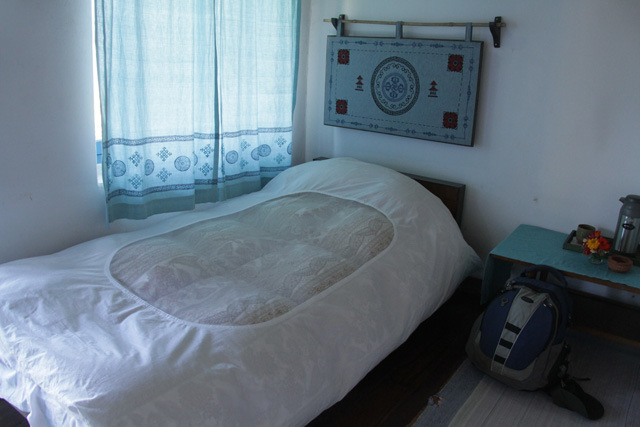
I met three people who had come from Bhaktapur to repair the furniture at the lodge. In the evening, Tul dai served us snacks and local spirits while we sat around an iron heater in the dining room, and the staff didis prepared our dinner. When I left the dining room, I was given a hot water bag. The sky was full of stars, and the chill was growing as I made my way to the room. Inside, the bed was warm and inviting, and in no time I quickly drifted off to sleep.
The View Tower
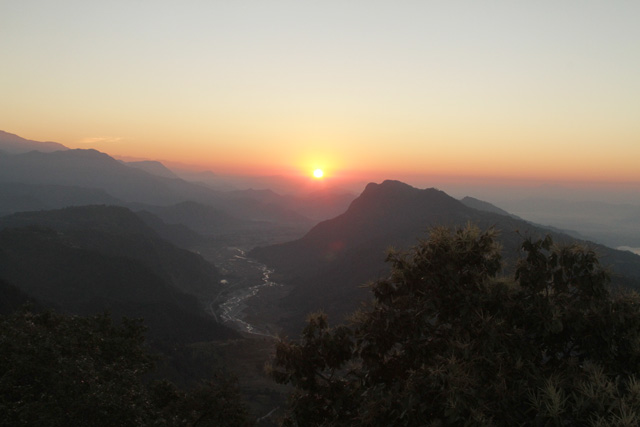
Next morning I went to the view tower. It was just a 10-minute-walk from the lodge.he lodge. It was built six months ago, and is located inside the Annapurna Conservation Area. It was a very steep climb to the top, but when I got to the tower, I was mesmerized by the views of Hiunchuli, Annapurna South, Machapuchhre, and Annapurana II and IV. The sun slowly rose at 6:25 a.m., casting its first rays on Machapuchhre, then Hiunchuli and the other peaks. In a matter of seconds, it became a fierce red, and spilled all over the horizon. It was such a spectacular scene that it made every climb worth it.
From the view tower, Thul dai and I went to Australian Base Camp with three other guests from the lodge.
Australian Camp
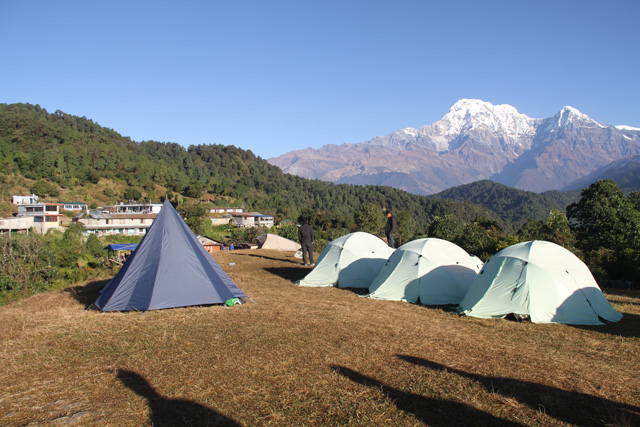
The campsite was about an hour’s hike from the lodge. After walking on a flat platform for few minutes, the hike climbed through a forest of kattus, chilaune, and uttis. The cries of cicadas filled the air as the trail got steeper. The sun was shining gloriously when we got to the top. There were several locals who had camped in the tents the night before. It cost NRs.800 to rent a tent.
From the hilltop, you could see close views of the whole Annapurna range. According to Tul dai, Annapurna III was hidden behind Machapuchhre, and Manaslu and Peak 29 could also be seen from here. At the end of the opposite hills, there was Lumle, which received the highest rainfall in Nepal. The place where the camp is located was originally called Thulo Kharka, but it has been more popular by its new name, Australian Camp, since the Australians camped here for over a week some 40 years ago.
Hike to Astam
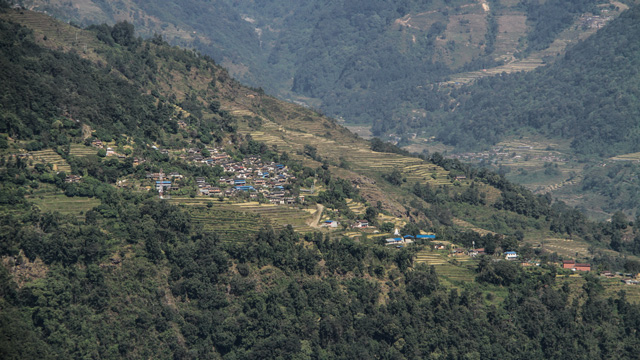
After a healthy breakfast of porridge, pancakes, boiled eggs, and some veggies, Tul dai and I set off for Astam at 11:00 a.m. It was a beautiful day. Cool wind was blowing as we descended downhill, passing through very old houses, some older than 100 years, in Dhampus. In some houses, women were making kheuni, a Gurung cuisine, and some of them were drying it on the roof. Between Dhampuskot and Astamkot, there were two more kots: Hemza kot and Jaykot. It is said that these villages were used for storing weapons at the time of baise and chaubise rajyas.
After entering the Jayakot Baraha jungle, I saw a walnut tree for the first time in my life. Then I saw another species of tree called Nigala in Dhital village. Nigala is used for making doko, nanglo, and dalo in villages. Hemzakot was the last village before we reached Hananoie in Astam.
Hananoie
 Hananoie, which means ‘house of flowers’ in Japanese, is perched on a hilltop in a tiny rural hamlet in Astam, Kaski. Built in 2001, this permaculture resort is spread over 75 ropanis of land and lies some 15 km northwest of Pokhara.
Hananoie, which means ‘house of flowers’ in Japanese, is perched on a hilltop in a tiny rural hamlet in Astam, Kaski. Built in 2001, this permaculture resort is spread over 75 ropanis of land and lies some 15 km northwest of Pokhara.
On arrival, I went to the lobby, which provided breathtaking views of the great Annapurna range. They offered me a warm towel and a fresh glass of juice before handing me the room keys. There are five cottages scattered on the property, each facing towards the mountains. Each has a spacious room that can accommodate up to four people, and has a private balcony with a large sitting area and garden views. The cottages are made of stone and mud and blends almost seamlessly with the natural surrounding. The mud plasters and antique wooden furniture give the rooms a rustic charm.
There is 22-seating capacity in the light-filled dining hall. They served me a bento lunch box in the afternoon. Except for fish, all vegetables in the set, including korokke, fried eggplant with radish sauce, and gomaae were grown in the resort.
After lunch, I was invited to look around the resort. They grew every kind of vegetable, from lettuce, parsley, hakusai (Japanese cabbage), bok choy, radish, carrots, beans, eggplants, broccoli, cauliflower, and capsicum, to spring onions, ginger, and garlic. The hotel staff were preparing to plant potatoes in a few days. The resort also grew its own coffee, and had kiwi, guava, and orange trees.
The resort allows guests to plant vegetables, and teaches them how to cook Nepali food if they like. Having chickens, buffaloes, goats, and apiaries in their farm, the resort never buys milk, butter, yogurt, meat, and honey from outside. The only item I didn’t see there was fish, which they brought from Pokhara.
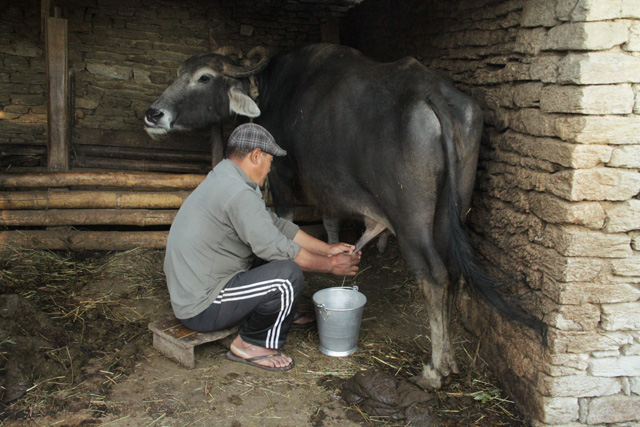
The resort uses only hand-woven, naturally dyed, or organic cotton fabrics, and they import handmade vegetable soaps from Morroco. As they don’t use any chemicals or pesticides, they’ve resorted to vinegar, baking powder, and bee’s wax for cleaning and housekeeping purposes. I was amazed when they gave me a lip balm that they had made in the resort itself. Even the candles in the room were made here.
This resort also has an ofuro facing the mountain peaks. All in all, it is the best example of an eco-friendly resort that takes sustainability initiative in all aspects of their operations. The next morning, I saw the sunrise from the resort, and saw how the staff made butter and milked the Buffalo. After breakfast, I started walking to Milanchowk, which I reached in about one hour, from where I took a cab to the Pokhara airport.










